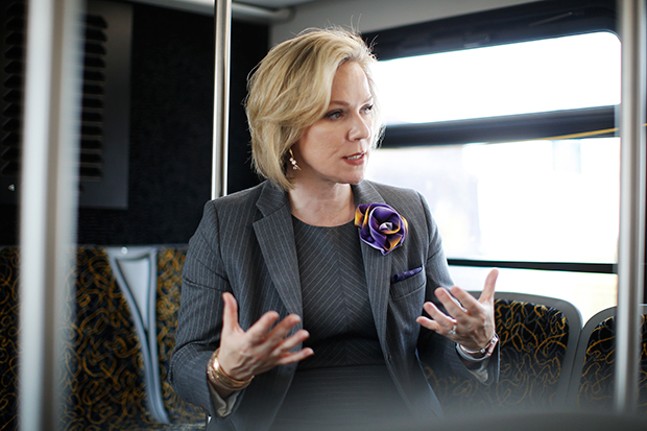
Driverless cars are on a lot of people’s minds. Autonomous vehicles are often spotted on Pittsburgh streets. And the Port Authority’s new CEO knows all about robots on the road.
In fact, Katharine Eagan Kelleman was a driving force behind an autonomous-shuttle pilot program when leading the transit agency for Hillsborough County, Fla.
But what happened in Tampa won’t fuel Kelleman in Pittsburgh, so don’t expect a similar program while she is running the Port Authority. She says Allegheny County is a “great, traditional public-transit county” and does not need big technology for improvements because of the large population of riders that are already dedicated to transit.
“I have experience in a city and state that is sprawly,” Kelleman says. “I understand why at places like that there is so much more desire to use ride hail and embrace the cool, the new and the neat.
“That is not the reality in Allegheny County.”
In her short time as CEO, Kelleman has prioritized a new vision for Port Authority: make trips better and more efficient for existing riders.
KELLEMAN UNDERSTANDS riders because she is a rider. She commutes to her Downtown office by driving a few minutes to the South Hills Village station, then taking light-rail the rest of the way.
During a 30-minute bus ride to and from Fineview and Downtown, she repeatedly mentions “riders” and “better” when speaking about Port Authority. She talks with conviction, underlining that a ridership increase in Allegheny County cannot happen until service improves for riders.
Her tactics are garnering attention.
Praise for Kelleman has come from public-transit advocates and skeptics. However, reality might prove a tougher opponent than critics. From 2016 to 2017, ridership dropped by 1.2 percent in urbanized sections of the region. And transit ridership is decreasing nationwide.
But Kelleman believes Pittsburgh’s slight dip can be overcome. “We have this pent-up demand,” she says.
Her optimism comes from experience.
Previous Port Authority leaders tended to have more local civic or business experience than transit expertise, but Kelleman has been working in public transit since age 24. Pittsburgh is the latest stop on road that has taken her to Dallas, Baltimore and Tampa.
She’s also a bit of transit nerd. While riding the 11 bus during this interview, Kelleman speaks about her time analyzing bus-stop locations and points out the correct distance a Downtown bus stop should be from the intersection.
She mentions public-transit consultant Jarrett Walker, a bit of an icon in her world. Walker has helped redesign bus networks in Seattle and Houston. Those cities have bucked the national trend and gained transit riders.
Kelleman wants similar results for Pittsburgh and Allegheny County. She is targeting service improvements such as consolidating bus stops and all-door boarding for the P1 route. She wants to beautify the region’s most used bus stops and renew focus on a marketing plan.
As she sees it, Port Authority needs to remind residents of the good transit that already exists. She mentions the speed and efficiency busway riders enjoy. A P1 bus trip from Wilkinsburg to Downtown takes about 15 minutes, while driving takes about 20. Kelleman hopes to make changes that will lead to more efficient bus trips for all riders.
To get the word out about these benefits, Port Authority’s board approved a $441-million budget that added 40 new positions at a $22-million expense.
Jake Haulk, who presides over the conservative Allegheny Institute for Public Policy, is a longstanding critic of Port Authority. He disagrees with a budget increase, an opposing view consistent with his concern about costs associated with running the agency.
Still, even Haulk is hearing something he likes from Kelleman.
“I would applaud route consolidation,” Haulk says. “There has to be efficiency measures completed at the Port Authority.”
BUCKING THE historical culture of the Port Authority appears to be Kelleman’s style. When the last Port Authority CEO was let go, some Port Authority board members weren’t informed until the night before they were set to vote.
Causes championed by the previous leadership have been rejected by Kelleman. After public outcry over the proposed Bus Rapid Transit line cutting Mon Valley service, she halted changes. When advocates voiced concerns about armed police monitoring fares on light-rail cars, Kelleman stopped that proposal, too.
Her rhetoric on transit even differs from local political leaders.
Both Peduto and Fitzgerald support the BRT and bus expansion, but Peduto also tweets about hyperloop and Fitzgerald backs highway expansion too. Kelleman is all about buses.
Since starting in January, Kelleman has upped the agency’s transparency by directly communicating with riders on social media and in person during her commute.
She says “people that ride in McKeesport want good, reliable public transit,” and in talking with them, Kelleman says riders never mention autonomous vehicles or other technological advances.
She takes that omission seriously.
“You can put in another subway line,” she says. “But nearly 200,000 are using our busses and existing network daily.
“The original ride share was the big bus that went from dense destination to other dense destinations. People are going to grocery stores and churches on our busses. We have to remember that.”
This doesn’t mean that Kelleman is opposed to new technology in transit. She is open to Pittsburgh’s tech sector providing improvements. Automatic stopping and blind-spot assistance comes to her mind, as does any advance that eases a driver’s job. But she does not wish to replace humans as bus drivers or light-rail operators.
This is good news for public-transit advocates.
“We are cautiously optimistic,” says Laura Wiens, director of Pittsburghers for Public Transit.
“It has been good to see her respond to the needs of riders. We are hopeful that will continue.”
Kelleman says transit is a “human and civil right,” echoing messaging of transit advocates such as Wiens.
The future of Pittsburgh’s transit is not what a casual observer might think now that Kelleman is in charge of Port Authority. Expect attractive bus stops, fewer confusing routes, and more frequent service.
“Small things that add up to a better agency,” Kelleman says.
And no robots.



